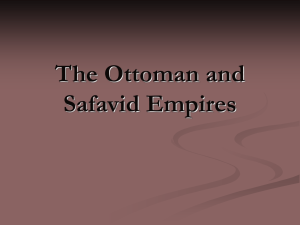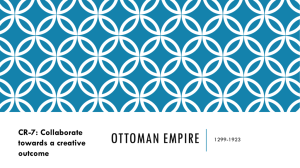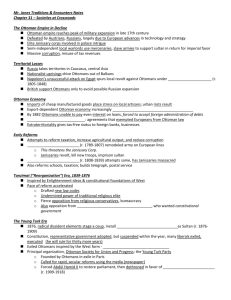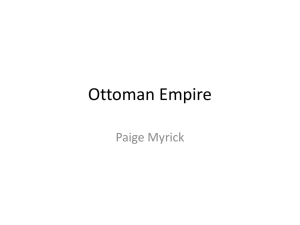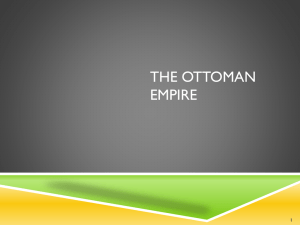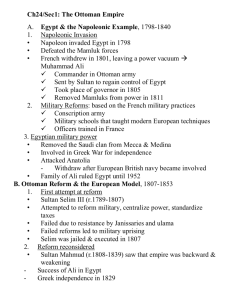The Ottoman Empire
advertisement
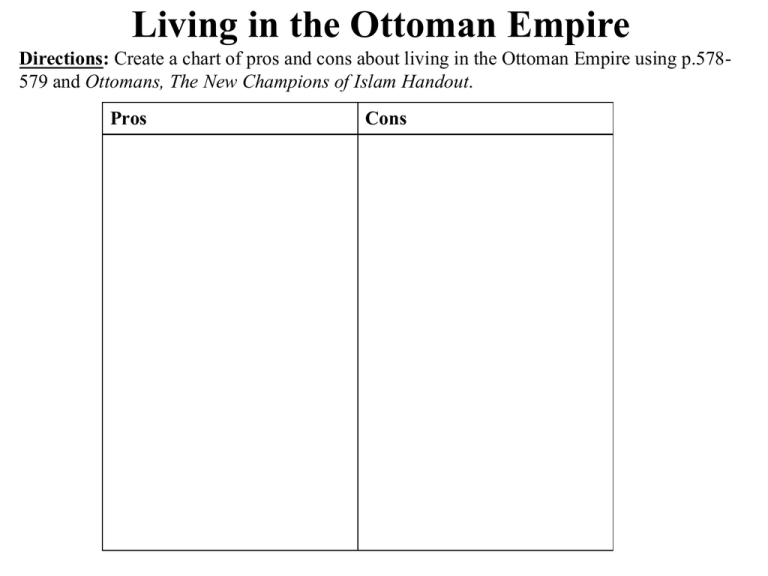
Living in the Ottoman Empire Directions: Create a chart of pros and cons about living in the Ottoman Empire using p.578579 and Ottomans, The New Champions of Islam Handout. Pros Cons The Ottoman Empire Empire of Faith: Ottomans The Ottomans:#1 Turkish speaking from Central Asia Muslim The last great Islamic empire in the world (1300-1900) Empire of Faith - Ottomans Beginning 0-4:10 Osman I (1280-1324)#2 founded Ottomans Ghazis: Islamic warriors who would conquer lands for plunder, glory, and to spread Islam Ghazis took control of old Seljuk territories, and expanded into Christian-held lands The Ottomans Osman I and his Ghazi Warriors Empire of Faith - Ottomans Devshirme 4:10 – 11:05 Civil Service and Social Structure Devshirme Practice of taking Christian boys between 10-20 years of age, converting them to Islam, and training them for positions in either: a) military – “Men of the Sword” b) civil service – “Men of the Pen” Civil Service and Social Structure Janissaries were trained as elite infantry in the Ottoman military Vizier High-ranking advisor to the Sultan. Often came from the devshirme system Empire of Faith - Ottomans Sultan Mehmet II 11:05 - 12:55 Sultan Mehmet II (1400) conquered Constantinople renamed it Istanbul new capital of the Ottoman Empire ended #3 Byzantine Empire Empire of Faith - Ottomans Cannons and Strategy 12:55- 16:24 Expansion Under their leader, Mehmet II, the Ottomans besiege and capture Constantinople 1453 This is a serious blow, as well as a threat, to Christian Europe. Ottomans were the first to use large numbers of muskets and cannons, which gave them military and technological superiority Siege of Constantinople The battle for Constantinople Empire of Faith - Ottomans Siege of Constantinople 16:24 – 21:29 Expansion The Ottomans then begin to expand eastward into Muslim-controlled territory Selim the Grim comes to power in 1512 after murdering his father and brothers Selim was an effective Sultan and General Sultan: title of Ottoman rulers Expansion Selim captures Arabia, Palestine, Persia, Syria, and sections of Egypt. Captures the holy cities of Mecca and Medina Ottomans now control much of the territory of the original Umayyad and Abbassid Caliphates Turkish Sultans would later take the title of caliph, giving them religious authority Ottoman Expansion What was the source of Ottoman power? #4 1. Political Stability skillful gov’t, bureaucracy 2. Control of Trade Location Control of the Waterways 3. Wealth from trade and taxes The lavishly decorated throne room of Topkapi Palace, home to Ottoman rulers until the early 20th century. 4. Superior technology (the benefit of diffusion) Suleiman the Magnificent Ottoman Empire reaches its height under Selim’s son, Suleiman. Suleiman rules for 46 years, from 1520 to 1566 Empire of Faith - Ottomans Suleiman 21:29 – 24:48 Suleiman the Magnificent His was sometimes called Suleiman the Lawgiver or Suleiman the Magnificent. Suleiman was also a great general. His armies conquered much of southern Europe (The Balkans) and North Africa – expands empire Expansion is finally stopped when he lays siege to Vienna, but fails to capture it. Golden Age Sultan Suleiman I (1520-1566) #5 Empire of Faith - Ottomans Suleiman 27:00 – 33:00 Show Suleiman the Magnificent Living in the Ottoman Empire Pros and Cons (see chart) Living in the Ottoman Empire Directions: Create a chart of pros and cons about living in the Ottoman Empire using p.578579 and Ottomans, The New Champions of Islam Handout. Pros Cons Sultan Suleiman I Magnificent or Lawgiver #5 skillful gov’t, bureaucracy Reforms to improve gov’t, justice and economy Tolerance Shariah - Timar millets: Self go verning; nonMuslim communities but loyalty to Sultans #6 Improved lives of slaves art, literature, architecture “Turkish style” (minarets) Domed Mosque Janizary - Devshirme Prosperous people=more taxes Social Structure – set Men of the Pen Men of the Sword Ruled with absolute power By 1540 rule ½ “civilized world” decline = inflation/poverty capitulations Civil Service and Social Structure Millets Provinces of the empire were allowed their own local government. Non-Muslim communities were loyal to sultan but were ruled by own religious leaders Included Jews, Armenians, Orthodox Christians Suleymaniye Mosque Istanbul, Turkey Currently a Museum, formerly an Imperial Mosque (1453–1931) and Roman Catholic Cathedral (1204– 1261); originally constructed as an Eastern Orthodox Cathedral (562– 1204, 1261–1453). Hagia Sophia, Istanbul The "Blue Mosque" of Sultan Amet I in Istanbul, Turkey. It was designed by the architect Mehemed Aja and built between 1609 and 1616 A.D. The sultan wanted his mosque to rival, if not surpass, the splendor of Hagia Sophia. This gem of Islamic architecture is known as the "Blue Mosque" because of the use of that color in the tiles and frescoes that decorate its interior walls. It has six minarets, a unique configuration. Empire of Faith - Ottomans Safavid Rivals 38:18 – 42:15 Chief Rivals: Safavids #7 Abbas the Great (shah: Persian King) 1587 – 1629 #9 Persia (present day Iran) Capital: Isfahan welcomed outside influence Trade and commerce Disputes: #8 Control of Mesopotamia Religious: Safavids: Shiite Ottomans: Sunni (Safavid from Islam DVD) Empire of Faith - Ottomans Siege of Vienna and Death of Suleiman 42:50 – end Or 48:50 - end Siege of Vienna: 1525 Ottoman Empire in Decline #10 The Europeans destroyed their strengths. Ottoman Strength #1: Control of trade. Europeans broke this strength by going around Africa and gaining control of trade. All water route Ottoman Strength #2: Wealth Discovery of the Americas = fantastic wealth for Europe from Aztec and Inca gold and silver. Ottoman Strength #3: Technology The industrial revolution surpassed the Ottoman superiority in technology especially in production of weapons The Empire Ends #11 Three reasons: 1. Nationalism: People ruled by the Ottomans wanted independence (Internal Force) Europeans: Serbs, Croats, Bulgarians, Greeks. Arabs 2. European Imperialism (External Force) Industrial revolution = need for raw materials European industries wanted new markets Large Military forces to control trade = Navy 3. Competition between European nations led to WWI in 1914 Rise and Decline of Ottoman Empire Interactive Map Causes of WWI 1914-1918 Rise of Nationalism in Europe Competition for Colonies Arms races and militarism Alliances The Ottomans sided with Central Powers (Germany) and lost. The Ottoman Empire along with its Arab territories were divided up between Great Britain and France.(mandates) Sykes-Picot Agreement Mandates A territory administered but not owned by a member of the League of Nations. Turkey becomes a nation (1923) Treaty of Lausanne

